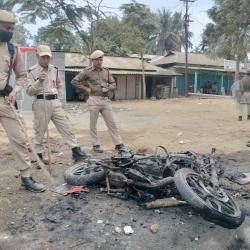The Dibang movement fell silent as the Union Minstry of Environment and Forests granted clearance to the project last September after a reduction in the dam height by10 metres. After the Dibang it is now the Demwe Lower that is gathering storm in Northeast India.
The 1,750-MW Demwe Lower mega hydel project—a 124-metre high dam proposed on the Lohit, a major tributary of the Brahmaputra in Arunachal Pradesh, has almost being pushed through had it not been for the Union Tourism and Culture Ministry’s objection that was the spanner at the last moment.
Interestingly, the Union Ministry of Environment and Forests did not make any mention of the Central Tourism Ministry’s objection to the project during submission before the National Green Tribunal. However, the Tribunal took cognizance of a case filed by local stakeholders opposing the mega project and that led to the stay on the proposed project.
The Assam Government in its affidavit placed before the National Green Tribunal has admitted that the fluctuations of water flow in Lohit and its contiguous water channels in the river Dibang in the north and river Dibru in te south of the Dibru-Saikhowa National Park will enhance and reduce the flow inside the numerous rivulets inside the Park. These channels are known for their concentration of gangetic dolphins. However, these are not the concerns that are taken as merits for the stay in the Demwe project. Rather, it is now faith versus development.
Religious sensitivity combined with tourism angle
Arunachal tourism claims the dam site is where Parashuram, a most ardent devotee of Lord Shiva, took a dip to cleanse himself of the sin of killing his mother at the instruction of his father with an axe that got stuck to his hand. The spot where the axe fell came to be known as Parasuram Kund,one of the most revered pilgrimage site in India with large number of devotees from across India and Nepal converging on the Kunda annually during Makar Sankranti.The site is a unique combination of cultural and biological diversity held sacred by not only the indigenous communities of Northeast India but across India, Nepal, Bhutan and Bangladesh and an important part of the international tourism circuit. The Union Tourism and Culture Ministry’s letter to the MoEF, seeking to protect the heritage, concludes:…If this project is allowed to be constructed, it will generate 23 lakh truck loads of debris, which will not only destroy the holy site of Parasuram Kunda, but also the ambience of the site, which will be converted to a dump yard.
Not only the site of Parasuram Kunda very important from cultural point of view, it is also very attractive tourist spot and the Ministry of Tourism has already sanctioned Rs.462.68 lakh to Arunachal Pradesh government for construction of a tourism complex at the holy site. This money has already been released to the state government during 2007-08 and has already been utilized by them. The construction of the Project and the dam will be disastrous for Parasuram Kunda, which is important from both cultural as well as tourism angle”.
The Arunachal BJP unit has demanded an investigation into how the Project was first allowed. It may be mentioned that the Demwe Lower project which has been hanging since 2011got a breather when Jayanthi Natarajan, the environment minister under the UPA regime, cleared it in 2012, setting aside objections of a wildlife expert committee.
With the new regime at the Centre refurbishing the entire clearance mechanism in order to speed up the implementation of hydropower projects as well as road projects in the strategically located border state, Arunachal apparently got a major shot in the arm on the hydropower front. Last year the Centre cleared the 3,000 MW Dibang Hydropower Project. The Dibang is one of the 168 massive dams in a series of mega dams planned in the Northeast—India’s “future powerhouse”. The damming programme is highly controversial as it fails to take into account geological and ecological factors as well as impacts of climate change in the region. Further it ignores all expert and advisory committees in the attempt to tap “clean energy”
Target set for 55,000MW by 2021
The grandiose plans of the Centre to generate 55,000MW from 160 odd dams in Arunachal is the most dreaded nightmare for downstream states as the cumulative impact of all the dams is likely to trigger catastrophic and irreversible consequences in the geologically and environmentally fragile Easter Himalayas.
Arunachal has plans for 44 hydropower projects with an estimated potential of 18000MW in the Siang sub basin and another 40 projects on the Kameng river basin with a combined capacity of 4,000MW. With substantial investments from big companies the state has set a target of generating not less than 40,000MW by 2021.
While Arunachal claims that the proposed projects would not only make Arunachal a power surplus state but would also meet the growing power shortage in the north eastern states, the downstream states like Assam has a different story to tell. The downstream impact of the big dams looms large over Assam. Hundreds of villages live with the nightmare of being washed away in case of any ecological disaster, the region being on a highly seismic zone.
The Siang becomes Brahmaputra in Assam and is the lifeline for millions of people. As such the projects on Siang and their impact on the environment have received greater focus. The ever receding water in the mighty river during the dry season is a grave concern with the people of the Brahmaputra valley. Similarly, the Kameng enters Assam as Bhoreli and there are growing concerns over the environmental impact.
Protests linked to survival of indigenous communities
While the protests over big dams are basically concerned with environmental impacts, the six-year long opposition to the Dibang dam, one of the world’s tallest dams on river Dibang-- another major tributary of the Brahmaputra—was largely driven by fears of demographic change that the project would bring with the migrant workforce. The protests were largely from the the Idu-Mishmi tribe, a community that barely has 12,000 members and scattered in the two districts spread across the Dibang basin.
The Forest Advisory Committee that examines the impact of infrastructure projects in wilderness areas earlier refused environmental clearances for the Dibang project even after several revised proposals concluding—“ecological and social costs of destroying a vast tract of forest land which is a major source of livelihood for the state’s tribal population would far outweigh the benefit likely to accrue from the project”.
Plea for environment audit
Opposition parties in Arunachal were demanding for environment audit in the state. One of the richest biodiversity zones in the Eastern Himalayan region, Arunachal Pradesh hardly has any policy initiative to protect its environment and rare wildlife.
The Dibang project alone will result in diversion of 5,056.5 hectares of forest land and felling of over three lakh trees while taking away shelter from various species protected under Schedule-1 like the rare goat-antelope species serow, goral and the Mishmi takin. Dumping of wastes into rivers and streams, uncontrolled mining, jhum cultivation and damming of rivers for hydropower generation heavily degraded the ecology of the region.
Parties like the NCP has demanded the Auditor general for taking up audit of mega power projects in both the public and private sectors and to take into account the accumulative effects on the lives and culture of the indigenous people.
- 19748 reads










Add new comment